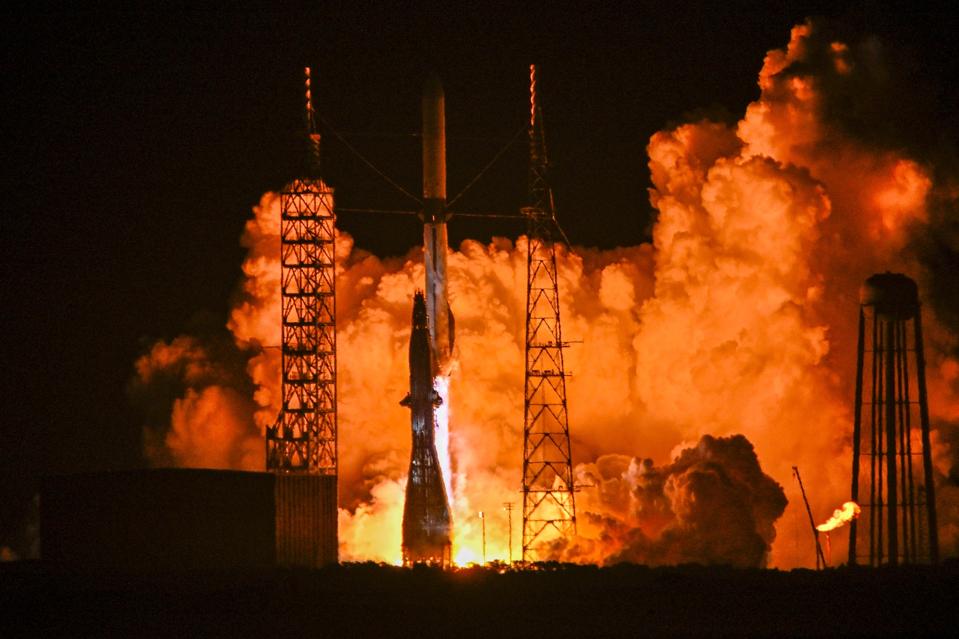
Blue Origin’s New Glenn rocket lifts off at Launch Complex 36 at Cape Canaveral Space Force Station prior to its scheduled 1 a.m. January 16 launch on January 16, 2025 in Cape Canaveral, Florida. (Photo by Miguel J. Rodríguez Carrillo/Getty Images)
Getty Images
In a mission that could redefine how humans get to Mars, NASA is set to launch its ESCAPADE mission next week aboard only the second flight of Jeff Bezos’ Blue Origin rocket, New Glenn.
As well as analyzing Mars’ magnetic field, the mission will test a pioneering new route that could become a key to human colonization of Mars.
NASA ESCAPADE Mission: Launch Date
Launching no earlier than 2:45 p.m. EST on Sunday, Nov. 9, from Cape Canaveral, Florida, the mission will ultimately deploy twin satellites — named Blue and Gold — built by California-based company Rocket Lab and designed to study the Martian magnetosphere in 3D.
Operated by UC Berkeley, ESCAPADE (Escape and Plasma Acceleration and Dynamics Explorers) is NASA’s first dual-satellite mission to another planet. However, what sets it apart is how it’s getting there.
A New Path To The Red Planet
Traditionally, Mars missions rely on the tight “Hohmann Transfer” window — just a few weeks every 26 months, either side of when Mars is closest to Earth (its opposition) — to travel efficiently to the Red Planet. Mars next reaches opposition on Feb. 19, 2027.
ESCAPADE, however, will use a radically different route, heading first to a solar-Earth Lagrange point where gravitational forces balance. It will loop for a year in a lazy, kidney-bean-shaped orbit before slingshotting back toward Earth and onward to Mars in late 2026. The satellites will arrive at Mars in 2027.
Close-up of ESCAPADE spacecraft conducting its science operations.
James Rattray/Rocket Lab USAHuman Colonization Of Mars
Its flexible new launch trajectory — though a consequence of the mission being delayed from October 2024 — may be critical to scaling future human missions to Mars.
Launching hundreds of crewed and uncrewed spacecraft to Mars simultaneously in a narrow window just before its opposition isn’t practical. The flexible-trajectory ESCAPADE pioneers could allow unlimited spacecraft to launch over many months, essentially forming a queue at a Lagrange point and beginning their journeys at the same time.
“Can we launch to Mars when the planets are not aligned? ESCAPADE is paving the way for that,” said Jeffrey Parker of Advanced Space LLC, one of NASA’s partners on ESCAPADE, at a conference earlier this year.
Martian Space Weather
Once at Mars, the twin satellites will study how the solar wind interacts with the Martian atmosphere — critical data for understanding how Mars lost its protective atmosphere and for shielding future astronauts from radiation, particularly during intense solar storms. After all, there’s no thick atmosphere or magnetic field like Earth’s to block them.
“We will be making the space weather measurements we need to understand the system well enough to forecast solar storms whose radiation could harm astronauts on the surface of Mars or in orbit,” said mission lead Dr. Robert Lillis of UC Berkeley. “It is definitely going to be a challenge to establish a human settlement on Mars,” he added. “But, you know, humans are tenacious, right?”
The ESCAPADE mission also aims to improve long-distance communication by studying Mars’ ionosphere. This layer could be used to bounce radio signals over the horizon — vital for navigating and surviving on the Martian surface.
A caravan transports a Blue Origin New Glenn rocket first stage past the Vehicle Assembly Building at Kennedy Space Center on Wednesday, Jan. 10, 2024, in Florida. (Richard Tribou/Orlando Sentinel/Tribune News Service via Getty Images)
TNSBezos’ Rocket Enters The Spotlight
For Bezos and Blue Origin, this mission marks a significant step forward. Blue Origin’s New Glenn rocket, named after astronaut John Glenn, has been in development for over a decade. Standing 321 feet tall and powered by seven BE-4 engines, it’s partially reusable and capable of lifting 45 tons to low-Earth orbit.
New Glenn will compete directly with Elon Musk’s Starship — especially as both rockets are central to NASA’s Artemis lunar program.
Wishing you clear skies and wide eyes.

